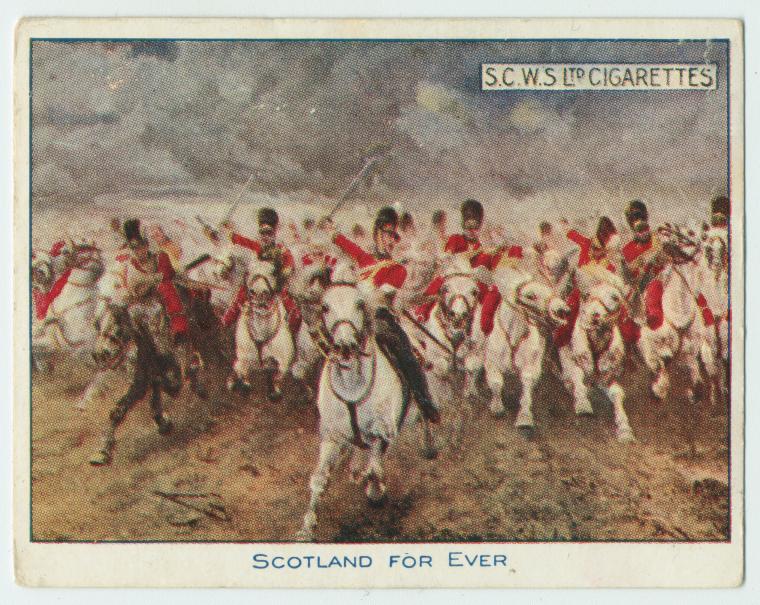
Scotland Forever! by Elizabeth Thompson (Lady Butler), 1846-1933. 1881. Oil on canvas. H 101.6 x W 194.3 cm. Collection: Leeds Art Gallery. Shown here is the Art-Journal engraving in Wilfrid Meynell's account of her life and work, facing p. 12. [Click on the image to enlarge it.]
In her autobiography, Lady Butler, as she was by this time, explained that the impulse for the painting came from having attended a show at the Grosvenor Gallery which upset her: she had disliked what she saw as the "sometimes unwholesome productions" of the avant-garde Aesthetes, had hurried home and "pinned a 7-foot sheet of brown paper on an old canvas and, with a piece of charcoal and a piece of white chalk, flung the charge of "The Greys" upon it" (186). Her own attitude as an artist was far removed from that of the Aesthetes' "Art for Art's Sake": it came from deep and conflicting feelings about the nature of war, shown on this canvas with inspired energy. Here are man and beast rising with fervour to the greatest of challenges, and at the same time, as the viewer then would have known only too well, hurtling towards their doom.
The work had a complex evolution. It was interrupted by a request from the Queen to paint a picture of war from her own times: the result was The Defence of Rorke's Drift (1880), about the recent battle in the Anglo-Zulu War, 1877-79, which was then being seen as a kind of "second Waterloo." This contemporary subject presented various problems for her, the first and most fundamental being, she explained, that it went against her principles "to paint a conflict" (187). Nevertheless, Rorke's Drift was a great success, both with the Queen and the public. There were some advantages to the interruption. When Lady Butler was able to pick up her work on the charging Scots again, she was living at Plymouth, where her husband was Adjutant-General, and she herself was in the early days of motherhood. But, with plenty of models at hand, and also "a supply of very brilliant Spanish white (bianco de plata)" (191), she achieved another triumph. Although a complicated legal dispute prevented her from showing it at the Royal Academy (the details are not fully known even now, see Usherwood and Spencer-Smith 43 and 83), it was shown at the Egyptian Hall in Piccadilly, and became her last great popular success.
Wilfrid Meynell makes the nature of the painting clear. The artist's contemporaries would have had a better understanding of the moment depicted:
Lady Butler shows in front the squadron leader; his trumpeter’s place should be at his left hand, but the horse of the trumpeter, feeling his rider reeling, has wavered and become engulfed in the front rank. Still he goes on, and has hardly finished sounding the charge before he is struck. That causes the pressure of horses — all, save the officers’, of a heavier breed than that now in use — in the front rank. The battle-cry has been uttered by most of the men, who, with lowered sabres, are delivering their charge under deadly artillery and infantry fire. [12]
It is one thing to learn from historical sources that "the regiment ... was almost annihilated in the charge" (Meynell 12). But another to understand that, here, on canvas, the artist has caught the very moment in which the final sacrifice is being exacted. The painting may be less immediately affecting than The Remnants of an Army, with its focus on one last drooping survivor of bitter conflict, but is perhaps her most intensely powerful, and was widely recognised as such.

Scotland Forever! on a cigarette card (George Arant Collection,
New York Public Library).
Bibliography
Butler, Elizabeth. An Autobiography. London: Constable, 1922. Internet Archive, from a copy in Robarts Library, University of Toronto. Web. 29 November 2024.
George Arents Collection, The New York Public Library. "Scotland For Ever." New York Public Library Digital Collections. Web. 30 November 2024. https://digitalcollections.nypl.org/items/510d47e2-f35d-a3d9-e040-e00a18064a99
Meynell, Wilfrid. The Life and Work of Lady Butler. London: The Art-Journal, 1898. Internet Archive, from a copy in the Getty Research Institute. Web. 29 November 2024.
Usherwood, Paul and Jenny Spencer-Smith. Lady Butler, Battle Artist, 1846-1933. Gloucester: Sutton and the National Army Museum, 1987.
Created 29 November 2024